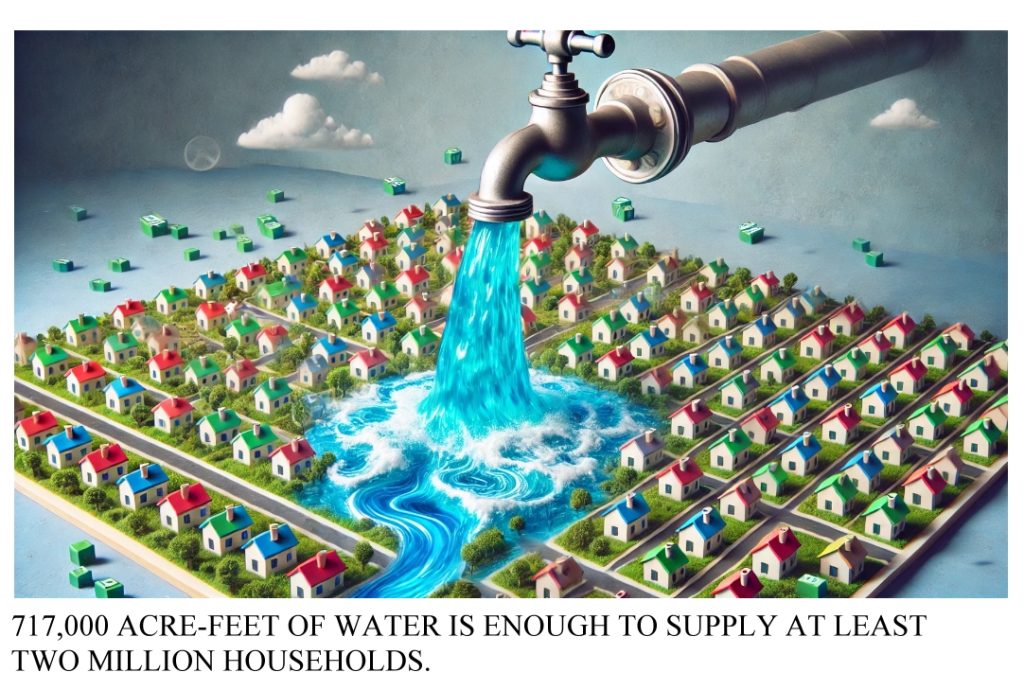- Agreements were signed to conserve over 790,000 acre-feet of water.
- Short-term deals to save 717,000 acre-feet by 2026.
- Long-term deals to conserve 73,000 acre-feet over ten years.
- Funding provided by President Biden’s Investing in America agenda.
- Efforts address historic drought in the Colorado River Basin.
September 27, 2024 — On Wednesday, the U.S. Department of the Interior announced significant progress in efforts to improve the health of the Colorado River System. In Santa Fe, New Mexico, Bureau of Reclamation Commissioner Camille Calimlim Touton joined leaders from California’s Imperial Irrigation District, Bard Water District, Metropolitan Water District, and Arizona’s Gila River Indian Community to sign five water conservation agreements.
significant progress in efforts to improve the health of the Colorado River System. In Santa Fe, New Mexico, Bureau of Reclamation Commissioner Camille Calimlim Touton joined leaders from California’s Imperial Irrigation District, Bard Water District, Metropolitan Water District, and Arizona’s Gila River Indian Community to sign five water conservation agreements.
Short-Term Conservation Agreements.
The agreements with the Imperial Irrigation District, Bard Water District, and Metropolitan Water District will conserve over 717,000 acre-feet of water by 2026. These short-term deals are part of the Lower Basin System Conservation and Efficiency Program, funded by the Inflation Reduction Act.
- Imperial Irrigation District: Aims to provide up to 700,000 acre-feet of conserved water to Lake Mead between 2024 and 2026, with an investment of approximately $589.2 million.
- Bard Water District and Metropolitan Water District: Will conserve up to 17,100 acre-feet of water at about $6.8 million during the same period.
This conserved water will remain in Lake Mead to benefit the Colorado River System and its users.

Long-Term Conservation Agreements.
The agreements with the Gila River Indian Community represent the first long-term deals signed under a $700 million investment announced in June from the Inflation Reduction Act. These agreements invest approximately $107 million into three projects with the potential to conserve over 73,000 acre-feet of water within the next ten years.
The Bureau of Reclamation is also working with other entities to negotiate additional water conservation contracts for up to 10 proposed projects. The funding for long-term initiatives in the Lower Basin is expected to save more than 1 million acre-feet of water.
Quotes from Officials.
“The Biden-Harris administration is committed to making western communities more resilient to the impacts of climate change,” said Secretary Deb Haaland . “With transformational resources provided through President Biden’s Investing in America agenda, the Interior Department is collaborating with states, Tribes, and partners to make smart investments to strengthen the stability and sustainability of the Colorado River System to support the families, farmers, and ecosystems that rely on this vital basin.”
. “With transformational resources provided through President Biden’s Investing in America agenda, the Interior Department is collaborating with states, Tribes, and partners to make smart investments to strengthen the stability and sustainability of the Colorado River System to support the families, farmers, and ecosystems that rely on this vital basin.”
“We are proud to announce these agreements that will support the long-term health of the Colorado River System by shoring up elevations,“ said Reclamation Commissioner Camille Calimlim Touton . “The agreements with the Imperial Irrigation District and the Bard Water District in partnership with the Metropolitan Water District will contribute a significant amount of system conservation through 2026, and the new agreements with the Gila River Indian Community are the beginning of our long-term investments that will improve the sustainability of our river for generations to come.”
. “The agreements with the Imperial Irrigation District and the Bard Water District in partnership with the Metropolitan Water District will contribute a significant amount of system conservation through 2026, and the new agreements with the Gila River Indian Community are the beginning of our long-term investments that will improve the sustainability of our river for generations to come.”
Background on the Colorado River Basin.
The Colorado River Basin provides water for more than 40 million people and supports hydropower resources in seven U.S. states. It is essential for 30 Tribal Nations and two states in Mexico and supports 5.5 million acres of agriculture. The region is currently experiencing the most prolonged and worst drought on record, exacerbated by hotter temperatures due to climate change.

Investments to Address the Drought.
President Biden’s Investing in America agenda includes significant investments to enhance the West’s resilience to drought and climate change. Through the Bipartisan Infrastructure Law, the Bureau of Reclamation is investing $8.3 billion over five years in water infrastructure projects, including water purification and reuse, water storage and conveyance, desalination, and dam safety. The Inflation Reduction Act is providing an additional $4.6 billion to address the historic drought.
Funding Highlights.
- Aging Infrastructure: Over $1.02 billion for repairs on water delivery systems in the Colorado River Basin states.
- Water Storage and Conveyance: More than $648 million in new investments.
- Water Recycling: $505 million for 26 projects expected to increase annual water capacity by hundreds of thousands of acre-feet.
- Water Conservation: Over $416 million in WaterSMART grants aimed at conserving tens of thousands of acre-feet of water.
These agreements and investments aim to put the Colorado River Basin on a path to a more resilient and sustainable water future, addressing the challenges of ongoing megadrought and climate change.


Leave a Reply